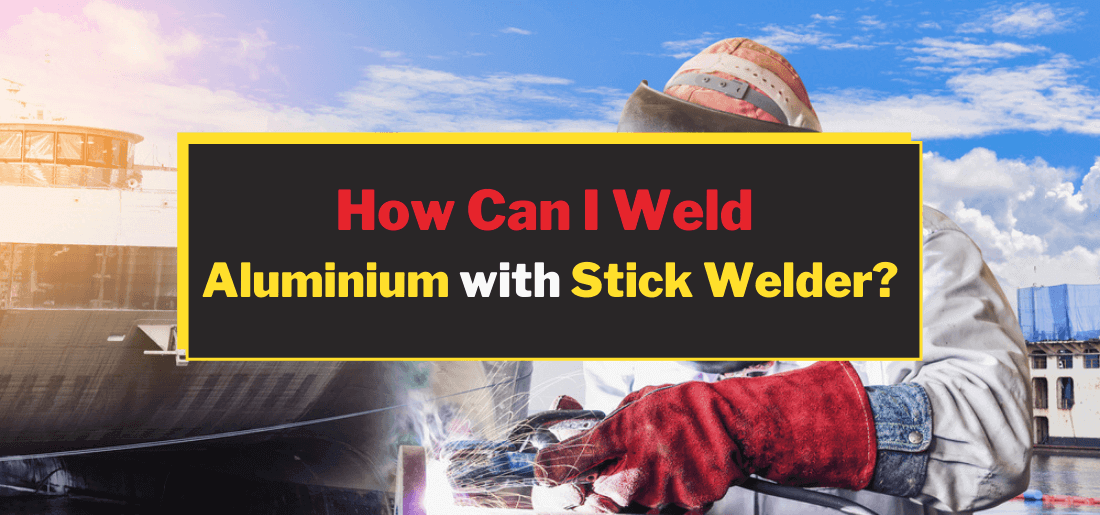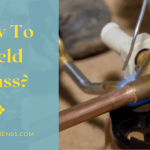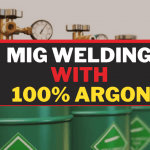Welding aluminum with a stick welder can be quite a daunting process because there is so much room for error. It can also be quite messy and a ton of things can go wrong. This difficulty has set the tone that you can’t weld aluminum with a stick welder at all. This is completely not true, however!
You need to be sure why you want to weld aluminum and whether you have the right kind of expertise to get it done. The reason why this process is made slightly more difficult is because of the properties of aluminum. This is quite a sensitive metal that has a way more oxidized exterior.
However, it is quite commonly used to repair tanks and pipes of all kinds. It can also be essential as the main material in high-rise buildings and since it can even be a component in aircraft construction, therefore it is quite worth the effort!
So, can I weld aluminum with a stick welder?
The simple answer to whether you can weld aluminum with a stick welder is yes! Just with any other kind of welding, the only thing you should be concerned with is if you are skilled and trained enough to commit to this process. This is because the art of welding aluminum with a stick welder is not for beginners!
This can mean that it is trickier to figure out how it will react to a stick welder. However, do not despair because today’s review will go into the specifics in detail. It will also look at other important aspects such as the best stick welding methods for aluminum, the basics you should keep in mind, and how stick welding works!
Best Stick Welding Methods for Aluminum
Next, let’s figure out the best stick welding methods for aluminum! There are 4 main ones you can choose to work with and we are about to highlight them for you!
The three main methods are the TIG welding method that is by far the cheapest way and so is also quite commonly used for aluminum welding. However, due to a better understanding of the welding process and higher quality results, people also use MIG, AC TIG and DC TIG welding as popular stick welding methods.
The best thing about these options is that you will need less training so you can get to work much quicker. No matter what method you might be using, you must keep in mind what the thickness of your metal is. This and how you need to arrange your metal piece is crucial.
With MIG or the metal inert gas welding method, you will appreciate that it is much faster than the traditional TIG. However, the TIG has its own set of advantages as it gives you more control over the process. This is thanks to there being no need for a filler metal as the base metal will easily melt.
With DC or direct current TIG welding, you can work on aluminum but it is important to remember that you should use it for thicker metal pieces. Each method of aluminum stick welding has its own set of advantages and limitations, however, the best one is to use AC TIG.
The reason behind its popularity is that although it might be slower, it is also the least messy. However, the only drawback it has is that you might have to work with thinner metals as compared to thicker ones.
What to Know About Stick Welding Aluminum
Moving on, it is also quite important that you know these basic things about stick welding aluminum!
So, what is important to know about stick welding aluminum?
Stick welding as a process is meant to make use of an electric arc to join metal pieces together. Of course, at the current and amperage this works, it will create large amounts of heat to melt your base metal.
One thing to keep in mind is that if you are using a coated electrode to melt the base metal, then you need to add a filler into your aluminum. This becomes necessary in the joining process of the 2 metals as one. When it comes to stick-based welding, this will warrant the need for an aluminum-coated electrode.
One thing that is both an advantage and a potential disadvantage with aluminum is that its welding process is quite quick. You will notice that your arc will not be in direct contact with the metal for too long. When it comes to stick-based welding, the best way to deal with aluminum is to work with a DC reversed polarity.
It also helps to have a flux-coated electrode to make the process more streamlined.
You also need to be aware of a few properties of aluminum and how they affect the welding process. This will impact your overall result and so are quite important when it comes down to the stick welding process.
- Aluminum has a tougher oxidizing layer when compared to other base metals. So to ensure that your overall weld is cleaner and has no signs of porosity, you can use a carburizing flame to heat it. This preheating process will ultimately ensure that your welding flows smoother.
- Since aluminum is formed with an oxide layer, you must deal with this by removing it. It can be taken care of with the aid of a stainless-steel wire brush as this is the most effective method to effectively clean your aluminum rod.
- You also need to remember that unlike other metals such as carbon steel, aluminum can dispel heat as fast as 4 times the speed. This is also why it tends to cool quicker and you have to act fast with this metal
- Aluminum is not the easiest metal to work with either since it is prone to cracking quite easily once the process is complete. This occurs when it cools too quickly.
One mistake that a lot of people make is to try and use the wrong kind of grinding wheel on their aluminum projects. This can be disastrous especially if the wheel is essentially meant for carbon steel instead. The issue with this is that it unknowingly causes oxidation to occur even faster.
Related Article: How To Strengthen Steel After Welding?
How Does Stick Welding Work?
Still, confused about how stick welding works? Let us help you!
First of all, you will need the following tools and equipment to get the best experience:
- You will of course need your stick welder that is your power supply and this should be at a constant voltage
- The next element you will need is your electrode or your rods and make sure there is a holder for them as well.
- Make sure you keep a Ground clamp handy
- Finally, the most important aspect! Safety! You will need to keep an apron, welding gloves, and goggles on hand at all times.
Once you have your equipment and basic tools ready, this is when your stick welding process starts. This is essentially a technique used to form your weld with the aid of a flux-coated electrode. You might have seen from the list, that this process doesn’t demand highly specialized equipment as it is fairly simple.
Using your power supply, you will pass an electric current through the electrode or rod. This then forms an arc where the base metal comes into contact.
This is when your electrode will start to melt and while the flux coating will get turned into gases, you will find that these gases are crucial to the process. They ensure that the melting metal does not oxidize.
Not only does it protect your rod from oxidizing but it is also quite easy to remove once your process is complete. It can easily be chipped off since it turns into slag as it cools down.
What to Keep in Mind About Stick Welding?
Let’s look over the most important factors to keep in mind about stick welding!
1) Your view should be clear and unobstructed
This should be a no-brainer however, sometimes this is more a force of habit than actual negligence. However, using protective eye gear or goggles that are worn out or scratched up can be potentially dangerous for you so it is best to replace them if necessary!
If you use a welding mask or helmet that has protective lenses make sure it is not dirty or murky before you start welding. If you aren’t the best with keeping up with their maintenance, make sure you at least purchase a replacement in case your first ones give out.
2) Know your options
This is a crucial aspect! You need to know what kind of machine you are utilizing as this will decide what kind of welding you can opt for. If you have a machine that has both AC and DC welding, then you will have more freedom to pick either. However, it also means you need to be aware of how to handle both.
On the other hand, if your machine is just AC, it makes your job easier to understand but of course, you lose out on other polarity choices. For the first option, it is important to note that DC or direct current means you can work with both reverse and straight polarity.
On the other hand, AC or alternating current will ensure it will flow both ways and that too simultaneously.
3) Know your amp and current setting keeping your chosen electrode in mind
This is quite an important factor primarily because the kind of electrode that you choose will determine how your welding process will go. Keep in mind that your amp and current settings will mean how much heat will be produced.
The most common size for welding rods that you can get from the market is 1/8-feet welding rods. Keeping this example in mind goes to show that the rod size should determine your overall amp and current starting point. Usually, your selected rods will have this printed on them but if not just go by the one amp per .001 diameter rule.
4) Always use the correct rod angle
Another element that is crucial here is finding the correct rod angle to work on. If you are welding vertically, then your angle should be about 10-degrees in the direction opposite to travel. This can be achieved by tilting the rod and it is called the pushing method.
On the other hand, if most of your welding will be in a flat position, you will still hold it at a 10-degree angle, however, the difference here is that you will work in the direction of the weld instead. This is called the backhand technique where you work in a dragging motion.
5) Make sure your base metals are clean before you weld
Finally, we think that your maintenance before you begin will essentially make your work more streamlined. For example, the easiest way to ensure that your weld is clean and has no elements of porosity, you should make sure your base metals are clean.
This includes getting rid of any buildup of grease, mill scale, moisture, oil, rust, or dirt from the surface where you will be doing your welding. Ultimately, this ensures you have a smooth and clean surface so that your final weld comes out looking better and more professional.
Final Words:
We are now at the very end of our detailed discussion on whether or not you can weld aluminum with a stick welder. This has been an in-depth look into the topic and should be a perfect guidance article for any beginner.
Ultimately, the important aspect is to keep the tips we have mentioned today in mind and to always wear safety gear while you work on your projects! We hope this has been an insightful and informative review for you and that you know more about aluminum welding now than you did before!




